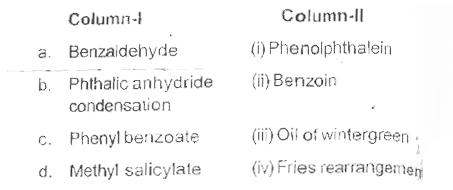Read the statements given below and identify the suitable option :
(i) Eye of Octopus and mammals are homologous.
(ii) sweet potato and potato are analogous.
(iii) Thorus of Bougainville and tendrils of Cucurbita are homologous
(i) is true and (ii ) is false
(ii) is true and (iii) is false
(i) and (ii) both are true
(i) is false and (ii) and (iii) true
The correct Answer is:D
To solve the question, we need to analyze each of the three statements given and determine their validity based on the definitions of homologous and analogous structures.
1. Analyze Statement (i):
- Statement: Eye of Octopus and mammals are homologous.
- Analysis: Homologous structures are those that have a similar anatomical structure but may serve different functions. The eyes of octopus and mammals, however, are structurally different despite both serving the function of vision. Thus, they are not homologous; they are considered analogous structures.
- Conclusion: This statement is false.
2. Analyze Statement (ii):
- Statement: Sweet potato and potato are analogous.
- Analysis: Sweet potato is a root modification, while potato is a stem modification. Despite their different anatomical structures, they serve a similar function of storing food. Therefore, they are classified as analogous structures.
- Conclusion: This statement is true.
3. Analyze Statement (iii):
- Statement: Thorns of Bougainvillea and tendrils of Cucurbita are homologous.
- Analysis: Thorns and tendrils may have different functions (protection vs. support), but they share a similar anatomical structure as both are modified stems. Hence, they are considered homologous structures.
- Conclusion: This statement is true.
4. Summarize the Results:
- Statement (i): False
- Statement (ii): True
- Statement (iii): True
5. Identify the Correct Option:
- The only option that matches our findings (first is false, second is true, third is true) is option 4.
Final Answer:
The correct option is option 4: First is false and Second and Third statements are true.
- Statement: Eye of Octopus and mammals are homologous.
- Analysis: Homologous structures are those that have a similar anatomical structure but may serve different functions. The eyes of octopus and mammals, however, are structurally different despite both serving the function of vision. Thus, they are not homologous; they are considered analogous structures.
- Conclusion: This statement is false.
- Statement: Sweet potato and potato are analogous.
- Analysis: Sweet potato is a root modification, while potato is a stem modification. Despite their different anatomical structures, they serve a similar function of storing food. Therefore, they are classified as analogous structures.
- Conclusion: This statement is true.
- Statement: Thorns of Bougainvillea and tendrils of Cucurbita are homologous.
- Analysis: Thorns and tendrils may have different functions (protection vs. support), but they share a similar anatomical structure as both are modified stems. Hence, they are considered homologous structures.
- Conclusion: This statement is true.
- Statement (i): False
- Statement (ii): True
- Statement (iii): True
- The only option that matches our findings (first is false, second is true, third is true) is option 4.
The correct option is option 4: First is false and Second and Third statements are true.
Similar Questions
Identify the following pairs of Homologous or Analogous organs:
i) Sweet potato and potato
ii) Eye of octopus and eye of mammals
iii) Thorns of Bougainvillea and tendrils of Cucurbits.
iv) Fore limbs of Bat and Whale.
View SolutionSelect the homologous structures from the combinations given below :
Forelimbs of whales and bats
Tuber of potato and sweet potato
Eyes of octopus and mammals
Thorns of Bougainvillea and tendrils of Cucurbita. (b) State the kind of evolution they represent.
View SolutionIdentify the examples of homologous structures from the following-
(i) Vertebrate hearts
(ii) Thorns in Bougainvillea and tendrils of Cucurbita.
(iii) Food storage-organs in sweet potato and potato.
View SolutionIdentify the examples of homologous structures from the following-
(i) Vertebrate hearts
(ii) Thorns in Bougainvillea and tendrils of Cucurbita.
(iii) Food storage-organs in sweet potato and potato.
View SolutionHow many of the following are examples of homologus structures in plant :
(a) Eyes of octapus and mammal
(b) Potato and sweet potato
(c) Forelimbs of whale, bat cheetah and human
(d) Vertebrate heart
(e) Thorn of bougainvillea and tendril of cucurbita
(f) Potato and corrot
(g) Potato and radish
View SolutionOut of the following , which , is an example of convergent evolution ?
(i) Eyes of octopus and mammals
(ii) Flipper of penguins and Dolphins
(iii) Sweet potato and potato
View SolutionChoose the pairs of organs that are a result of convergent evolution
i. Wings of butterflies and wings of birds.
ii. Flippers of penguins and flippers of dolphins
iii. Eyes of octopus and eyes of mammals.
iv. Thorns of Bougainvillea and tendrils of Cucurbita.
v. Sweet potato and potato.
vi. Vertebrate hearts and vertebrate brains
View SolutionMatch the compounds given in Column-I with Column-II and select the suitable option using the code given below

View SolutionIs sweet potato analogous or homologous to potato tuber ? Give reasons to support your answer.
View SolutionWhich one of the following options gives one correct example each of convergent evolution and divergent evolution ?
Convergent evolutionDivergent evolution(1)Thorns of Bougainvillea and tendrils of CucurbitaWings of butterflies and birds(2)Bones of forelimbs of vertebrates Wings of butterflies and birds(3)Thorns of Bougainvillea and tendrils of CucurbitaEyes of octopus and mammals(4)Eyes of octopus and mammalsBones of forelimbs of vertebrates
View Solution
